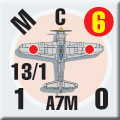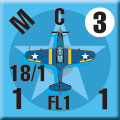The Emperor’s Sword:
A Split Decision
by Mike Bennighof, Ph.D.
July 2024
 I had intended for The Emperor's Sword, an expansion for Second World War at Sea, to be the Pacific equivalent of our Plan Z set. Given the bigger fleets and broader canvas of the Pacific War, it would be very large (by our standards, anyway) and bring both our Midway Deluxe and South Pacific games into an alternative history where a much larger and wealthier Japanese Empire has built a fleet capable of meeting the Americans on an equal footing. I had intended for The Emperor's Sword, an expansion for Second World War at Sea, to be the Pacific equivalent of our Plan Z set. Given the bigger fleets and broader canvas of the Pacific War, it would be very large (by our standards, anyway) and bring both our Midway Deluxe and South Pacific games into an alternative history where a much larger and wealthier Japanese Empire has built a fleet capable of meeting the Americans on an equal footing.
South Pacific is the largest game in our lineup, and at this writing, it’s out of print. It’s a hard sellout; we don’t have any appreciable number of parts for it. I could send The Emperor’s Sword to press without South Pacific around, but that would crimp the sales of both products. Or I could delay The Emperor’s Sword to wait for South Pacific, but that would make a lot of fans sad. Or I could print both of them together (The Emperor’s Sword and South Pacific), but that would soak up all of our resources and we would have no other releases for a good long stretch, which would go very badly for us.
So what I have decided to do, in a burst of Solomonic (Solomonic!) wisdom, is to slice this baby in half.

The Emperor’s Sword will have half as many pieces as planned (two sheets rather than four), coming to 420 pieces: 140 double-sized “long” ship pieces and 280 square ones, mostly aircraft. It will draw only on Midway Deluxe Edition for its maps and other pieces (note that the maps and pieces for Midway Deluxe are substantially different than those of earlier editions; The Emperor’s Sword will not be compatible with older versions of Midway).
And then when we have South Pacific back, we’ll issue another expansion set, with the other two sheets of pieces and probably a map, too, so we can take the war to Fiji. This one would draw only on South Pacific for its maps and other pieces.
The Emperor’s Sword, as re-made, is all about carrier battles. The story opens in December 1943, with Hawaii as a client kingdom of the Japanese Empire, having been so since 1893. And in those five decades, the Empire’s political, economic, and cultural roots have sunk deep into the islands. The Pearl River Estuary is a major Japanese naval base, while the rest of the islands are a major destination for Japanese vacationers. And now the Americans have come to try to wrest them away from the Empire.

They’ve done so with a powerful fleet, including more aircraft carriers. More Lexington-class carriers, converted from battle cruisers. Passenger liners converted to carriers, under the Maritime Commission’s program of subsidizing merchant ships that could be requisitioned for military use. Additional battleships: two more of the North Carolina class. Two classes of proposed alternatives to North Carolina. BB47 Washington, completed and ready for battle alongside her sisters of the Colorado class. And more cruisers in support, including flight-deck cruisers for scouting.
And on those flight decks, new aircraft: the FL1 Airabonita, and the TBY Sea Wolf.
But the conceit behind The Emperor’s Sword is to build a Japanese fleet that can stand up to the massive American mid-war naval buildup with their own battleships, carriers, cruisers and destroyers. In this reality, Battleship Row is populated by modernized ships of the Tosa, Kii, and Mino (known in our history as “Number 13”) classes.
Plus you get three more super-battleships of the Yamato class, two early alternative Yamato designs, and the Type 64 fast battle cruiser. Scads of new cruiser and destroyer designs to support and screen them, too.
 
Our alternative Midway campaign (which takes place mostly on the opposite end of the map from Midway Island) is a carrier war. And the Japanese bring the carriers, too. Starting with the Amagi-class battle cruisers, all four of them converted into fleet carriers (in our history, only one was converted, along with the battleship Kaga, which appears here as a battleship). Plus additional members of the Hiryu, Soryu and Shokaku classes.
All of those flight decks will need new aircraft, and that’s what the Emperor has provided for his air fleets. The next generation of Japanese carrier air power is here: the A7M Reppu fighter, D4Y Suisei dive bombers, B6N Tenzen and B7A Ryusei torpedo bombers. The Japanese Navy land-based air force gets J1N, N1K2J and A7M fighters, P1Y, G8M and G7M bombers, and N1K1 and H8K seaplanes.
If all of the above seems like a twisted word salad, don’t worry. We’ll also tell you all about those ships and planes. For now, just trust me: the hard-core shipheads are squirming in excited anticipation.

The split into two distinct expansion sets gives us much more space in the scenario book to tell two related, but separate stories. And this is why I do this job, so I can tell stories.
The story of The Emperor’s Sword begins with the Hawaiian Islands within the Japanese Empire, well-defended by a major fleet, land-based air forces and a strong garrison. The Japanese are aware of American interest in the islands, and eagerness to take them. But they do not expect their rivals to attack without a declaration of war, thereby subverting their own constitutional process.
In game terms, this means that we get to use the Pearl Harbor tactical display, with Japanese battleships lined up on Battleship Row and American carrier planes bombing them. This is the real reason I crafted this story; I just liked the surreality of it. But a surprise attack is not enough to capture the islands, and the Japanese still have a strong fleet to defend them. If the Americans want to capture them, their invasion fleet will have to fight its way past and conduct contested landings.

It's an improbably long way from San Francisco to Honolulu, but only a little farther than the distance from Tokyo to Honolulu, over which the Japanese conducted their own attempted invasion in 1942. Almost all of the air support has to come from the decks of American carriers (that’s the purpose of those converted liners), but they do have a secret weapon, the ultra-long-range B19 heavy bomber that can make the round-trip journey from the United States bearing 16 tons of bombs. That is a great many bombs.
This is not the sort of thing you’ll find from other publishers. I’ve no idea why; there have been games about Midway and the wider Pacific War since 1964 (!), longer than I and most of you have been alive. To want to fight out the battles with the ships and planes that were designed but never built seems a natural impulse to me. If that’s your way of thinking too, you’re probably a strange person also, but The Emperor’s Sword is for you.
Click here to join the Gold Club
See your Gold Club Insider newsletter for ordering information.
Sign up for our newsletter right here. Your info will never be sold or transferred; we'll just use it to update you on new games and new offers.
Mike Bennighof is president of Avalanche Press and holds a doctorate in history from Emory University. A Fulbright Scholar and NASA Journalist in Space finalist, he has published a great many books, games and articles on historical subjects; people are saying that some of them are actually good.
He lives in Birmingham, Alabama with his wife and three children. He will never forget his Iron Dog, Leopold.
Want to keep Daily Content free of third-party ads? You can send us some love (and cash) through this link right here.
|
